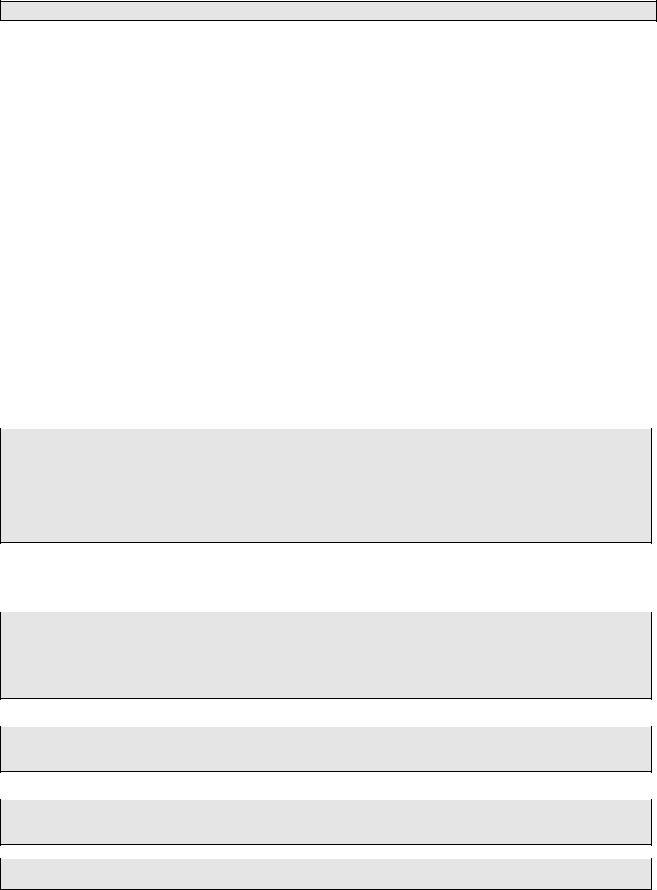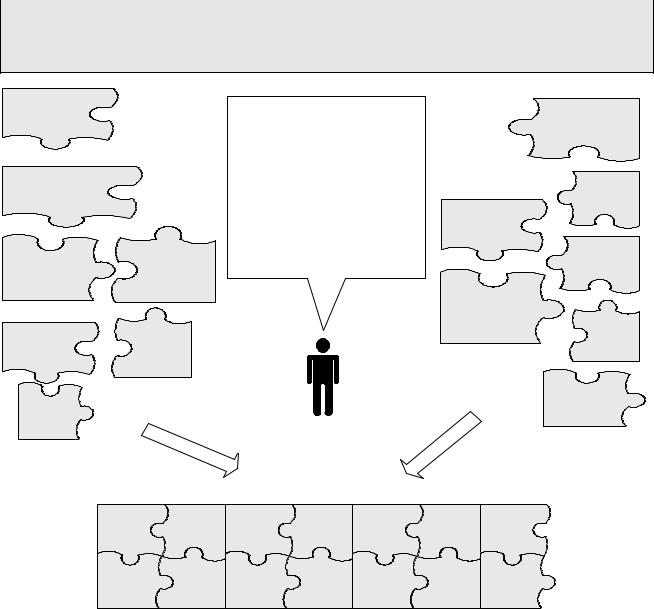
Java_J2EE_Job_Interview_Companion
.pdf
1
Learn Java/J2EE core concepts and key areas
With
Java/J2EE Job Interview Companion
By
K.Arulkumaran
&
A.Sivayini
Technical Reviewers
Craig Malone
Stuart Watson
Arulazi Dhesiaseelan
Lara D’Albreo
Cover Design, Layout, & Editing
A.Sivayini
Acknowledgements
A. Sivayini
Mr. & Mrs. R. Kumaraswamipillai
2
Java/J2EE
Job Interview Companion
Copy Right 2005-2007 ISBN 978-1-4116-6824-9
The author has made every effort in the preparation of this book to ensure the accuracy of the information. However, information in this book is sold without warranty either expressed or implied. The author will not be held liable for any damages caused or alleged to be caused either directly or indirectly by this book.
Please e-mail feedback & corrections (technical, grammatical and/or spelling) to java-interview@hotmail.com
First Edition (220+ Q&A): Dec 2005
Second Edition (400+ Q&A): March 2007

3
Outline
SECTION |
DESCRIPTION |
|
|
|
|
|
What this book will do for you? |
|
|
|
|
|
Motivation for this book |
|
|
|
|
|
Key Areas index |
|
|
|
|
SECTION 1 |
Interview questions and answers on: |
|
|
Java |
|
|
|
Fundamentals |
|
|
Swing |
|
|
Applet |
|
|
Performance and Memory issues |
|
|
Personal and Behavioral/Situational |
|
|
Behaving right in an interview |
|
|
Key Points |
|
|
|
SECTION 2 |
Interview questions and answers on: |
|
|
Enterprise Java |
|
|
|
J2EE Overview |
|
|
Servlet |
|
|
JSP |
|
|
JDBC / JTA |
|
|
JNDI / LDAP |
|
|
RMI |
|
|
EJB |
|
|
JMS |
|
|
XML |
|
|
SQL, Database, and O/R mapping |
|
|
RUP & UML |
|
|
Struts |
|
|
Web and Application servers. |
|
|
Best practices and performance considerations. |
|
|
Testing and deployment. |
|
|
Personal and Behavioral/Situational |
|
|
Key Points |
|
|
|
SECTION 3 |
Putting it all together section. |
|
|
How would you go about…? |
|
|
1. |
How would you go about documenting your Java/J2EE application? |
|
2. |
How would you go about designing a Java/J2EE application? |
|
3. |
How would you go about identifying performance problems and/or memory leaks in your Java |
|
|
application? |
|
4. |
How would you go about minimizing memory leaks in your Java/J2EE application? |
|
5. |
How would you go about improving performance of your Java/J2EE application? |
|
6. |
How would you go about identifying any potential thread-safety issues in your Java/J2EE |
|
|
application? |
|
7. |
How would you go about identifying any potential transactional issues in your Java/J2EE |
4
|
|
application? |
|
8. |
How would you go about applying the Object Oriented (OO) design concepts in your Java/J2EE |
|
|
application? |
|
9. |
How would you go about applying the UML diagrams in your Java/J2EE project? |
|
10. |
How would you go about describing the software development processes you are familiar with? |
|
11. |
How would you go about applying the design patterns in your Java/J2EE application? |
|
12. |
How would you go about designing a Web application where the business tier is on a separate |
|
|
machine from the presentation tier. The business tier should talk to 2 different databases and your |
|
|
design should point out the different design patterns? |
|
13. How would you go about determining the enterprise security requirements for your Java/J2EE |
|
|
|
application? |
|
14. |
How would you go about describing the open source projects like JUnit (unit testing), Ant (build |
|
|
tool), CVS (version control system) and log4J (logging tool) which are integral part of most |
|
|
Java/J2EE projects? |
|
15. |
How would you go about describing Service Oriented Architecture (SOA) and Web services? |
|
|
|
SECTION 4 |
Emerging Technologies/Frameworks |
|
|
|
Test Driven Development (TDD). |
|
|
Aspect Oriented Programming (AOP). |
|
|
Inversion of Control (IoC) (Also known as Dependency Injection). |
|
|
Annotations or attributes based programming (xdoclet etc). |
|
|
Spring framework. |
|
|
Hibernate framework. |
|
|
EJB 3.0. |
|
|
JavaServer Faces (JSF) framework. |
|
|
|
SECTION 5 |
Sample interview questions … |
|
|
|
Java |
|
|
Web Components |
|
|
Enterprise |
|
|
Design |
|
|
General |
|
|
|
|
GLOSSARY OF TERMS |
|
|
|
|
|
RESOURCES |
|
|
|
|
|
INDEX |
|
|
|
|

5
Table of contents
Outline_________________________________________________________________________________________ 3 Table of contents ________________________________________________________________________________ 5 What this book will do for you? ____________________________________________________________________ 7 Motivation for this book __________________________________________________________________________ 8 Key Areas Index ________________________________________________________________________________ 11 Java – Interview questions & answers _____________________________________________________________ 13
Java – Fundamentals _____________________________________________________________________________________ 14 Java – Swing ____________________________________________________________________________________________ 69 Java – Applet____________________________________________________________________________________________ 76 Java – Performance and Memory issues _____________________________________________________________________ 78 Java – Personal and Behavioral/Situational __________________________________________________________________ 83 Java – Behaving right in an interview________________________________________________________________________ 89 Java – Key Points ________________________________________________________________________________________ 91
Enterprise Java – Interview questions & answers ____________________________________________________ 94
Enterprise - J2EE Overview ________________________________________________________________________________ 95 Enterprise - Servlet ______________________________________________________________________________________ 108 Enterprise - JSP ________________________________________________________________________________________ 126 Enterprise – JDBC & JTA_________________________________________________________________________________ 145 Enterprise – JNDI & LDAP ________________________________________________________________________________ 155 Enterprise - RMI ________________________________________________________________________________________ 159 Enterprise – EJB 2.x _____________________________________________________________________________________ 163 Enterprise - JMS ________________________________________________________________________________________ 180 Enterprise - XML ________________________________________________________________________________________ 190 Enterprise – SQL, Database, and O/R mapping_______________________________________________________________ 197 Enterprise - RUP & UML __________________________________________________________________________________ 206 Enterprise - Struts_______________________________________________________________________________________ 214 Enterprise - Web and Application servers ___________________________________________________________________ 218 Enterprise - Best practices and performance considerations ___________________________________________________ 222 Enterprise – Logging, testing and deployment _______________________________________________________________ 225 Enterprise – Personal and Behavioral/Situational_____________________________________________________________ 228 Enterprise – Software development process_________________________________________________________________ 230 Enterprise – Key Points __________________________________________________________________________________ 233
How would you go about…?_____________________________________________________________________ 238
Q 01: How would you go about documenting your Java/J2EE application? FAQ________________________________ 239 Q 02: How would you go about designing a Java/J2EE application? FAQ _____________________________________ 240 Q 03: How would you go about identifying performance and/or memory issues in your Java/J2EE application? FAQ _ 243 Q 04: How would you go about minimizing memory leaks in your Java/J2EE application? FAQ __________________ 244 Q 05: How would you go about improving performance in your Java/J2EE application? FAQ _____________________ 244 Q 06: How would you go about identifying any potential thread-safety issues in your Java/J2EE application? FAQ __ 245 Q 07: How would you go about identifying any potential transactional issues in your Java/J2EE application? FAQ __ 246

6
Q 08: How would you go about applying the Object Oriented (OO) design concepts in your Java/J2EE application? FAQ 247
Q 09: How would you go about applying the UML diagrams in your Java/J2EE project? FAQ _____________________249
Q 10: How would you go about describing the software development processes you are familiar with? FAQ ________251
Q 11: How would you go about applying the design patterns in your Java/J2EE application? _____________________253
Q 12: How would you go about designing a Web application where the business tier is on a separate machine from the presentation tier. The business tier should talk to 2 different databases and your design should point out the different design patterns? FAQ____________________________________________________________________________________286
Q 13: How would you go about determining the enterprise security requirements for your Java/J2EE application? ___287
Q 14: How would you go about describing the open source projects like JUnit (unit testing), Ant (build tool), CVS (version control system) and log4J (logging tool) which are integral part of most Java/J2EE projects? ________________292
Q 15: How would you go about describing Service Oriented Architecture (SOA) and Web services? FAQ ___________299
Emerging Technologies/Frameworks… ____________________________________________________________311
Q 01: What is Test Driven Development (TDD)? FAQ _______________________________________________________312 Q 02: What is the point of Test Driven Development (TDD)? What do you think of TDD?__________________________313 Q 03: What is aspect oriented programming (AOP)? Do you have any experience with AOP? _____________________313 Q 04: What are the differences between OOP and AOP? ____________________________________________________317 Q 05: What are the benefits of AOP?_____________________________________________________________________317 Q 06: What is attribute or annotation oriented programming? FAQ ___________________________________________317 Q 07: What are the pros and cons of annotations over XML based deployment descriptors? FAQ _________________318 Q 08: What is XDoclet? ________________________________________________________________________________319 Q 09: What is inversion of control (IoC) (also known more specifically as dependency injection)? FAQ_____________319 Q 10: What are the different types of dependency injections? FAQ ___________________________________________321 Q 11: What are the benefits of IoC (aka Dependency Injection)? FAQ _________________________________________322 Q 12: What is the difference between a service locator pattern and an inversion of control pattern? _______________323 Q 13: Why dependency injection is more elegant than a JNDI lookup to decouple client and the service? ___________323 Q 14: Explain Object-to-Relational (O/R) mapping? ________________________________________________________323 Q 15: Give an overview of hibernate framework? FAQ ______________________________________________________324
Q 16: Explain some of the pitfalls of Hibernate and explain how to avoid them? Give some tips on Hibernate best practices? FAQ _________________________________________________________________________________________333
Q 17: Give an overview of the Spring framework? What are the benefits of Spring framework? FAQ _______________334 Q 18: How would EJB 3.0 simplify your Java development compared to EJB 1.x, 2.x ? FAQ ______________________337 Q 19: Briefly explain key features of the JavaServer Faces (JSF) framework? __________________________________339
Q 20: How would the JSF framework compare with the Struts framework? How would a Spring MVC framework compare with Struts framework?___________________________________________________________________________________341
Sample interview questions… ____________________________________________________________________344
Java___________________________________________________________________________________________________345 Web components________________________________________________________________________________________345 Enterprise ______________________________________________________________________________________________345 Design_________________________________________________________________________________________________347 General ________________________________________________________________________________________________347
GLOSSARY OF TERMS__________________________________________________________________________348
RESOURCES __________________________________________________________________________________350
INDEX ________________________________________________________________________________________352

7
What this book will do for you?
Have you got the time to read 10 or more books and articles to add value prior to the interview? This book has been written mainly from the perspective of Java/J2EE job seekers and interviewers. There are numerous books and articles on the market covering specific topics like Java, J2EE, EJB, Design Patterns, ANT, CVS, Multi-Threading, Servlets, JSP, emerging technologies like AOP (Aspect Oriented Programming), Test Driven Development (TDD), Dependency Injection Dl (aka IoC – Inversion of Control) etc. But from an interview perspective it is not possible to brush up on all these books where each book usually has from 300 pages to 600 pages. The basic purpose of this book is to cover all the core concepts and key areas, which all Java/J2EE developers, designers and architects should be conversant with to perform well in their current jobs and to launch a successful career by doing well at interviews. The interviewer can also use this book to make sure that they hire the right candidate depending on their requirements. This book contains a wide range of topics relating to Java/J2EE development in a concise manner supplemented with diagrams, tables, sample codes and examples. This book is also appropriately categorized to enable you to choose the area of interest to you.
This book will assist all Java/J2EE practitioners to become better at what they do. Usually it takes years to understand all the core concepts and key areas when you rely only on your work experience. The best way to fast track this is to read appropriate technical information and proactively apply these in your work environment. It worked for me and hopefully it will work for you as well. I was also at one stage undecided whether to name this book “Java/J2EE core concepts and key areas” or “Java/J2EE Job Interview Companion”. The reason I chose “Java/J2EE Job Interview Companion” is because the core concepts and key areas discussed in this book helped me to be successful in my interviews, helped me to survive and succeed at my work regardless what my job (junior developer, senior developer, technical lead, designer, contractor etc) was and also gave me thumbs up in code reviews. This book also has been set out as a handy reference guide and a roadmap for building enterprise Java applications.

8
Motivation for this book
I started using Java in 1999 when I was working as a junior developer. During those two years as a permanent employee, I pro-actively spent many hours studying the core concepts behind Java/J2EE in addition to my hands on practical experience. Two years later I decided to start contracting. Since I started contracting in 2001, my career had a muchneeded boost in terms of contract rates, job satisfaction, responsibility etc. I moved from one contract to another with a view of expanding my skills and increasing my contract rates.
In the last 5 years of contracting, I have worked for 5 different organizations both medium and large on 8 different projects. For each contract I held, on average I attended 6-8 interviews with different companies. In most cases multiple job offers were made and consequently I was in a position to negotiate my contract rates and also to choose the job I liked based on the type of project, type of organization, technology used, etc. I have also sat for around 10 technical tests and a few preliminary phone interviews.
The success in the interviews did not come easily. I spent hours prior to each set of interviews wading through various books and articles as a preparation. The motivation for this book was to collate all this information into a single book, which will save me time prior to my interviews but also can benefit others in their interviews. What is in this book has helped me to go from just a Java/J2EE job to a career in Java/J2EE in a short time. It has also given me the job security that ‘I can find a contract/permanent job opportunity even in the difficult job market’.
I am not suggesting that every one should go contracting but by performing well at the interviews you can be in a position to pick the permanent role you like and also be able to negotiate your salary package. Those of you who are already in good jobs can impress your team leaders, solution designers and/or architects for a possible promotion by demonstrating your understanding of the key areas discussed in this book. You can discuss with your senior team members about performance issues, transactional issues, threading issues (concurrency issues) and memory issues. In most of my previous contracts I was in a position to impress my team leads and architects by pinpointing some of the critical performance, memory, transactional and threading issues with the code and subsequently fixing them. Trust me it is not hard to impress someone if you understand the key areas.
For example:
Struts action classes are not thread-safe (Refer Q113 in Enterprise section).
JSP variable declaration is not thread-safe (Refer Q34 in Enterprise section).
Valuable resources like database connections should be closed properly to avoid any memory and performance issues (Refer Q45 in Enterprise section).
Throwing an application exception will not rollback the transaction in EJB. (Refer Q77 in Enterprise section).
The other key areas, which are vital to any software development, are a good understanding of some of key design concepts, design patterns, and a modeling language like UML. These key areas are really worthy of a mention in your resume and interviews.
For example:
Know how to use inheritance, polymorphism and encapsulation (Refer Q7, Q8, Q9, and Q10 in Java section.).
Why use design patterns? (Refer Q5 in Enterprise section).
Why is UML important? (Refer Q106 in Enterprise section).
If you happen to be in an interview with an organization facing serious issues with regards to their Java application relating to memory leaks, performance problems or a crashing JVM etc then you are likely to be asked questions on these topics. Refer Q72 – Q74 in Java section and Q123, Q125 in Enterprise section.
If you happen to be in an interview with an organization which is working on a pilot project using a different development methodology like agile methodology etc or has just started adopting a newer development process or methodology then you are likely to be asked questions on this key area.
If the team lead/architect of the organization you are being interviewed for feels that the current team is lacking skills in the key areas of design concepts and design patterns then you are likely to be asked questions on these key areas.

9
Another good reason why these key areas like transactional issues, design concepts, design patterns etc are vital are because solution designers, architects, team leads, and/or senior developers are usually responsible for conducting the technical interviews. These areas are their favorite topics because these are essential to any software development.
Some interviewers request you to write a small program during interview or prior to getting to the interview stage. This is to ascertain that you can code using object oriented concepts and design patterns. So I have included a coding key area to illustrate what you need to look for while coding.
Apply OO concepts like inheritance, polymorphism and encapsulation: Refer Q10 in Java section.
Program to interfaces not to implementations: Refer Q12, Q17 in Java section.
Use of relevant design patterns: Refer Q11, Q12 in How would you go about… section.
Use of Java collections API and exceptions correctly: Refer Q16 and Q39 in Java section.
Stay away from hard coding values: Refer Q05 in Java section.
L an g u ag e F u n d a m en ta ls
S p e c ific a tio n
F u n d am e n ta ls
D es ig n
P atte rn s
Co n c u rre n c y Is s u e s
C O d in g
S E cu rity
Sc ala b ility Iss u e s
H ow m any books do I have to read to understand and put together all these key areas?
H ow m any years of experience should I have to understand all these key areas?
W ill these key areas help m e progress in m y career?
W ill these key areas help m e cut quality code?
P erfo rm a n ce
Is s u e s
E x c ep tio n H a n d lin g
S o ftw are
De v elo p m e n t P ro c e ss
D e s ig n
C o n ce p ts
T ra n s a ctio n a l Is s u es
B e s t P rac tic es
M e m o ry
Is su e s
L F D C C I P I S E E H S D
D P S F M I S I T I B P C O
This book aims to solve the above dilemma.
My dad keeps telling me to find a permanent job (instead of contracting), which in his view provides better job security but I keep telling him that in my view in Information Technology the job security is achieved only by keeping your knowledge and skills sharp and up to date. The 8 contract positions I held over the last 5.5 years have given me broader experience in Java/J2EE and related technologies. It also kept me motivated since there was always something new to learn in each assignment, and not all companies will appreciate your skills and expertise until you decide to leave. Do the following statements sound familiar to you when you hand in your resignation or decide not to extend your contract after getting another job offer? “Can I tempt you to come back? What can I do to keep you here?” etc. You might even think why you waited so long. The best way to make an impression in any organizations is to understand and proactively apply and
